Device profile: Divitron Aura — a portable DVB-T monitoring instrument
Jun 20, 2003 — by LinuxDevices Staff — from the LinuxDevices Archive — 6 viewsDivitron's Aura is a light weight, portable field test and monitoring instrument for terrestrial digital video broadcasting (DVB-T) network builders and operators. The device, which is basically a “tablet PC” with an integrated Linux-controlled DVB-T receiver and instrumentation subsystem, is used for testing and verifying DVB-T broadcast signal quality and coverage area.
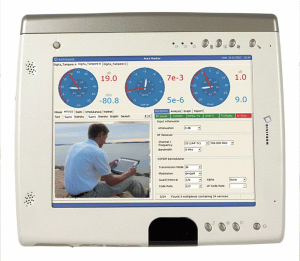
DVB basics
According to Divitron, Digital Video Broadcasting (DVB) is projected to begin to replace traditional analog TV systems in Europe over the next two to five years. DVB includes several standards, including ones for satellite (DVB-S) and cable (DVB-C) which have been around since 1995, and one for “terrestrial” point-to-point broadcast purposes (DVB-T) which was finalized toward the end of 1996.
DVB-T serves the needs of both stationary and portable/mobile reception of broadcast and data services. However, although DVB-T's outdoor reception quality is generally considered adequate, providing acceptable indoor reception quality remains a challenge, according to Divitron.
DVB-T network operators, broadcasters, and antenna specialists are therefore in need of instruments to assist them in testing and improving the quality of DVB-T indoor reception — and Divitron developed the Aura to provide this capability.
What the Aura does
According to Divitron, the Aura provides all of the required DVB-T measurements in real time, in the form of an industrial-grade, portable tablet PC with a built-in DVB-T receiver and monitoring instrumentation. It can log measurement data to a file and send it to collection points via email.
The device has a bright, 10.4-inch full-color LCD display, weighs approximately 5 pounds, and has a built-in UHF antenna and can be operated using a convenient remote control.
Under the hood
Architecturally, the Aura is a dual-processor system — the combination of a slate-style Tablet PC, plus a custom “intelligent” DVB-T receiver subsystem.
The “tablet PC” portion of the system is based on an 866MHz Intel mobile PIII processor with 256MB SDRAM, running Microsoft Windows XP Tablet PC Edition — as on most Tablet PCs. This “Wintel” subsystem handles the user interface, graphical display, data storage (on a 20 GB hard drive), and the communications capabilities of the instrument (which include emailing data to collection locations).
The DVB-T receiver subsystem, which is located in a pod attached to the rear of the tablet PC, is based an embedded computer consisting of a 108MHz IBM PowerPC “Digital Set-Top Box Integrated Controller” system-on-chip processor with 32MB of RAM (see photo below), running MontaVista Linux, which boots from Flash memory. The PowerPC/Linux embedded computer handles the control and measurement functions of the DVB-T receiver subsystem.
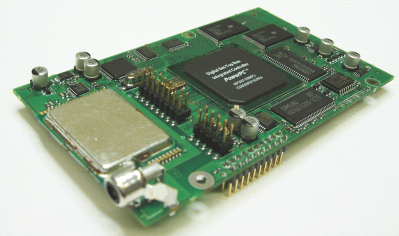
The PowerPC/Linux-based DVB-T receiver subsystem
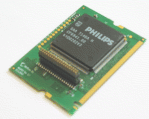 The interface between the Tablet PC and the DVB-T receiver subsystem is via a custom mini-PCI card (shown at left) which plugs into a mini-PCI card socket inside the Tablet PC. (mini-PCI is often used for adding things like Wi-Fi WLAN or mobile phone radios to notebook and tablet PCs.) A header connector inteface on the mini-PCI card mates with a corresponding one on the DVB-T receiver module.
The interface between the Tablet PC and the DVB-T receiver subsystem is via a custom mini-PCI card (shown at left) which plugs into a mini-PCI card socket inside the Tablet PC. (mini-PCI is often used for adding things like Wi-Fi WLAN or mobile phone radios to notebook and tablet PCs.) A header connector inteface on the mini-PCI card mates with a corresponding one on the DVB-T receiver module.
Here is a photo of the rear of the completed instrument:
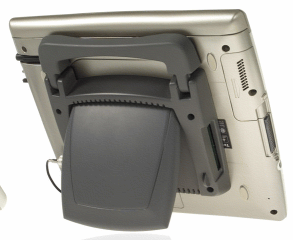
Why Linux?
“We considered a proprietary operating system, but the business model and licensing scheme the vendor offered did not meet our needs,” commented Divitron CEO Matti Lipsanen. “Linux gives us access to source code and to the large pool of available Linux programmers.”
Additionally, Lipsanen noted that MontaVista added to the inherent value of open source Linux, by supplying Divitron with a combination of useful tools, pretested support packages for the required IBM PowerPC processor, and “comprehensive support and training.”
Typical operation
Below, we see the Aura in action, measuring DVB-T signals at a typical indoor location . . .
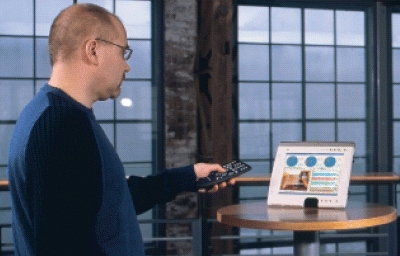
About Divitron
Divitron Inc., based in Turku, Finland was founded in 2002 with initial seed funding from Nokia's “Early Stage Technology Fund.” With its origins in Nokia R&D, the company is continuing to develop technologies that are strategically important to Nokia, especially in the area of DVB-T-compliant solutions to ensure high quality DVB service reception, for both in-home and mobile environments.
This article was originally published on LinuxDevices.com and has been donated to the open source community by QuinStreet Inc. Please visit LinuxToday.com for up-to-date news and articles about Linux and open source.